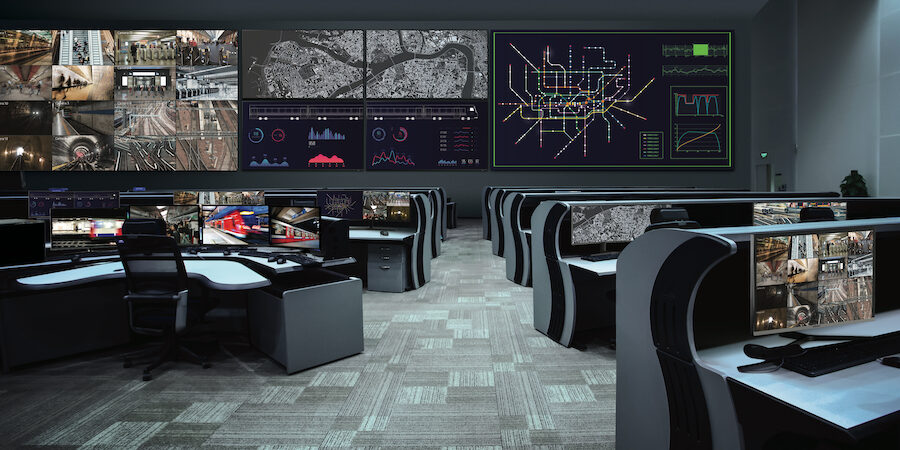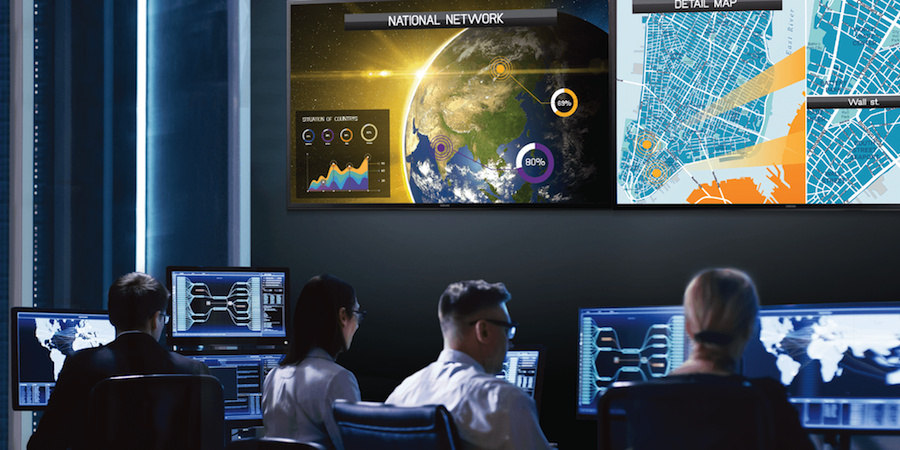A smart city control room display gives leaders real-time visibility of streets, transit lines, utility services and high-traffic areas. Data flowing into the control room can help cities use public funds more wisely and make communities safer and more efficient.
Yet, for all this promise, a smart city control room setup must reflect the realities of running a modern metropolis. The staff needs technology that’s easy to use and makes their jobs more efficient. And a robust smart city infrastructure might pull in data feeds from dozens of sources. Network endpoints can include outdoor cameras, electric vehicle charging stations, sensors in sanitation trucks and signals from traffic lights.
Everything must flow over a high-capacity network into a smart city nerve center, where computers analyze data points and use advanced learning algorithms to tell leadership what’s happening now and what they can expect months or years down the road. The constant among this galaxy of variables is the giant-screen control room display that puts everything into perspective.
Smart city displays that accommodate the everyday challenges of municipal managers must have four core qualities:
1. Simplicity
Giant-screen display manufacturers are making strides in simplifying the setup and configuration of control room displays, a process that was traditionally cumbersome and time-draining. The Samsung All-in-One LED IAC illustrates just how far things have come.
This 130-inch-wide display is designed to be installed in about two hours. A basic bracket system docks two background plates on four preset modules. There’s no box or cord dangling below the screen because all controls are integrated into the unit. This provides a cleaner, less distracting visual surface. The screen also has built-in speakers, saving another installation chore.
Many cities have in-house staff capable of setting up a system this simple. And if they don’t, their vendors won’t need to bill for a lot of setup time, potentially saving money on the installation.
2. Expandability
A well-equipped smart city control room should have at least one giant-screen display. But bigger municipalities with more resources and more ambitious programs might need two or more giant screens. Samsung All-in-One displays are designed for easy expansion.
An expandable display network also must have strong integration with desktop monitors used by control room staff. They’ll need TAA-compliant monitors to drill down on data points, real-time indicators and messaging from leadership and field personnel. These monitors should deliver high-dynamic range visuals with more than a billion high-contrast colors. The best monitors also have flicker-control technology to reduce eyestrain.
Smart city control room monitors also need an integrated keyboard, video and mouse (KVM) switch for moving back and forth between applications.
Samsung’s comprehensive ecosystem of displays work together to build a seamless, modern control room. From large-scale LED signage and video walls visible to the entire room to ultra-wide, high resolution monitors, smart city teams will have the technology to get the job done.
Integrate digital signage in the control room
Streamline mission-critical workflows and content management with secure, large-format displays. Download Now
3. Security
Giant-screen monitors are network endpoints, which means they’re vulnerable to cyberattacks if not secured. This is one area where Samsung excels.
The Samsung Knox security program provides military-grade protection of devices at the chip level. It also prevents malicious changes to system software and applications. Everything the company learns about security can be applied across its product line via the Knox program.
This high-grade security is essential for city governments, which often have a hard time hiring and retaining cybersecurity talent.
4. Clarity
The latest LED-based giant-screen displays are vast improvements on previous generations of video technology because they’re bright enough to operate in any light level — including direct sunlight. Control rooms no longer have to operate in the dark with the window shades drawn.
LEDs (short for light-emitting diodes) can be configured to produce extremely dark blacks in giant-screen displays. This creates sharp visual contrast and limits reflections that make big screens difficult to view.
The millions of microscopic LED lights in giant-screen displays also produce the sharp, precise images and vivid colors that decision makers need in smart city control rooms.
More things to look for in giant-screen LED displays
The best smart city control room displays should have:
- Remote power operability. Displays should be able to stay live around the clock, even during electricity outages.
- Software enhancements. Samsung, for instance, uses AI algorithms to enhance low-resolution images in real time and provide an immediate clarity boost.
- High endurance. Top-quality displays are designed to resist damage from impacts, moisture, overheating and static shock.
- Seamless integration. Smart city data feeds come from a vast assortment of devices and applications. Giant-screen displays should easily integrate data from these kinds of sources.
- Automation. Supporting software should accelerate the application of remote data, performing tasks like auto-populating the assigned fields from sensor feeds. This makes it easier for control room operators to use data in the ways that are most useful to them.
Smart cities need simple display choices
Data, algorithms and AI are transforming city leaders’ ability to streamline public services and make their streets safer. While these tools deliver impressive results, they also complicate the lives of civic leaders, requiring a deft balance of time, skills and budget.
But one decision doesn’t have to be complicated: Choosing a giant-screen display for a smart city control room. The latest all-in-one LED displays are easy to use and simple to set up. They follow the tightest security standards while delivering vivid images and long-lasting performance.
That’s smart and simple, which is just what city leaders need.
Learn more about the Samsung All-in-One LED IAC. And get our free guide with everything you need to know to initiate your LED digital signage deployment.









